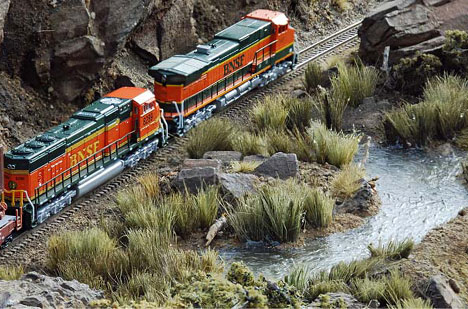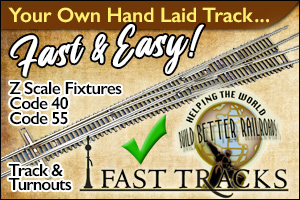Start Small In Z Scale
 Whenever I talk to a potential new user interested in Z scale, I tend to be a bit conservative. One of the real benefits of Z scale is that in a relatively small space you can have operating yards, passing sidings, double mainlines, etc., great stuff. No question Z scale can excel at this, lots of terrific eye candy and interesting operations.
Whenever I talk to a potential new user interested in Z scale, I tend to be a bit conservative. One of the real benefits of Z scale is that in a relatively small space you can have operating yards, passing sidings, double mainlines, etc., great stuff. No question Z scale can excel at this, lots of terrific eye candy and interesting operations.
This sort of layout is the first thing I advise new Z scalers to avoid! It’s not that big, interesting layouts can’t be done in Z scale, they most certainly can. I advise against big layouts right off the bat so that new users can get their feet wet with a simple track plan, my favorite for new users is an oval with a pair of turnouts. That’s it, simple! I also suggest they pick up a single locomotive, maybe a couple of freight cars and a throttle. This is of course the classic beginner’s setup in most scales, but often times I see beginners in Z scale start bigger.
Maybe it’s because Z is smaller and folks want to quickly populate their layouts, to fill the space. Z may be smaller but try to do too much right off the bat and you can get overwhelmed and frustrated. We really are in a great period of Z scale with high quality locomotives from Micro-Trains and AZL. Sectional track systems from Micro-Trains and the newcomer Rokuhan make constructing you trackwork quick and reliable. Still, get those feet wet first!
If you plan to do a lot of switching, run your new Z scale locomotive through your turnouts repeatedly. Get a feel for minimum speeds needed for smooth travel. Play with an uncoupler track section to see if Z scale meets your needs for operations.

A diorama built for Jürg Rüedi by Ztrains
Don’t plan on a lot of switching operations? Still I’d suggest you run your loco and cars over and over on your newbie test loop at slow, medium and high speeds. Even on a basic loop, you’ll probably want at least a basic passing siding or two. Test these sidings out and determine if they operate as you want, as you expect. Basically kick the heck out of the tires!
If you have a problem or questions at this early stage in your Z scale adventure, there are plenty of online resources to help you out with your questions. If you have a problem or a question with your basic loop and turnouts… it’s manageable. If on the other hand you’ve got boxes and boxes of track, locos and cars and you have a problem at this beginning stage… it can be a little maddening and disheartening. Start small!
In addition to starting small with the actual track and trains, I’d also suggest you do a little scenery work at this point. You can buy a very basic Z scale laser kit for under $10, it’s a great investment and litmus test for you! Build or buy some trees, a rock mold or two… build a mini-scene for yourself to make sure Z scale is for you.
I’m of course hooked on Z scale and it’s sometimes easy to forget the learning curve we all went through, not just in Z scale but in any model railroad scale. Start small, ask questions and build on your successes, you’ll be glad you did!
Category: Introduction To Z Scale















